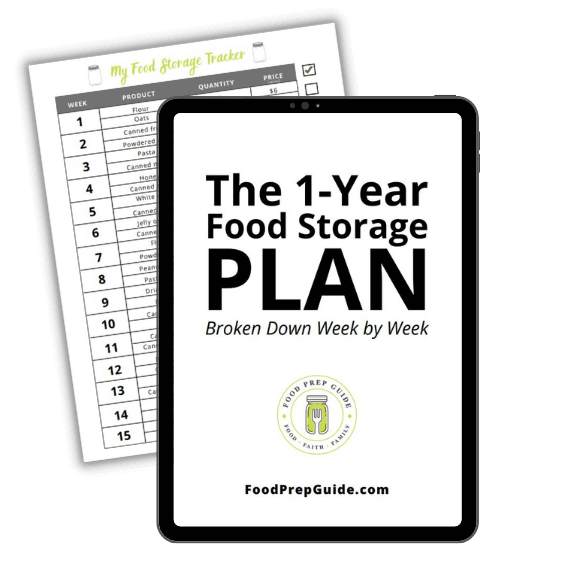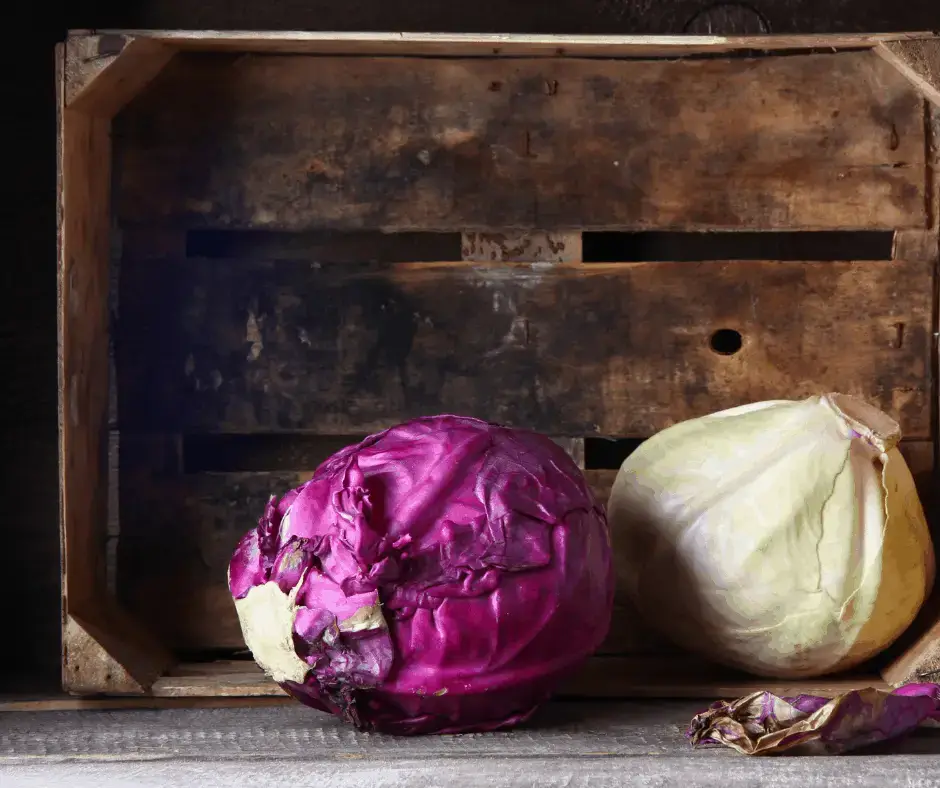Cabbage is a pretty hardy vegetable that’s slow to spoil. But there are actually things you can do to make cabbage last twice as long as it normally would.
So let’s talk about storing cabbage the right way so you can get the most bang for your buck.
First, Check for Signs of Worms and Pests (Then Do This)
Before you store your cabbage, make sure you’re not bringing pests into your house. Look it over carefully for any hidden worms or insects.
(Check out this post if you’re struggling with cabbage worms.)
You can do this pretty quickly by checking for signs they’ve burrowed inside. If you notice any little holes or “bitten” edges, you should soak the cabbage in salt or vinegar water for about 20 minutes.
This solution won’t change the final its taste but will remove any pests present. Let it drain well before storing.
How to Store Cabbage in the Freezer
You can always store cabbage in the fridge but freezing it will extend its shelf-life. Once you’ve washed the cabbage, shred it finely with a food processor or by hand.
Then blanch it for two minutes and immerse in cold water to cool. Pack in freezer-proof containers or bags and place in the freezer.
Another option for freezing is to keep the cabbage intact – aka don’t shred it. If you prefer this, clean the cabbage just like you would for any other preparation method and then prepare into whole leaves or wedges.
You can blanch them with this process as well although it’s not required.
Lay the cabbage in single layers on cookie sheets and then place in the freezer. They should be frozen completely within 24 hours. Pack them into freezer containers, leaving 1/2 inch headspace and store for up to 12 months in the freezer.
To Blanch or Not to Blanch?
Although it’s not strictly required to blanch, taking this extra step helps to preserve both the color and flavor, so it’s a good idea.
If you don’t want to blanch it, just be sure to purchase cabbage that’s as fresh as possible. When you’re not blanching, you also want to freeze it quickly.
Most people will use the cabbage cut into wedges when they don’t blanch it, but it’s really up to you and your preference.
Leave the core intact as it will help preserve the cabbage even longer.
How to Store Cabbage Without Refrigeration
Although we frequently store fruits and vegetables in the fridge or freezer, this isn’t necessary for all types of produce.
Cabbage doesn’t require any specific storage methods and can be stored in cabinets much as you would potatoes or onions.
You simply want to avoid condensation so store in a place that’s not too damp and has decent ventilation for the best results.
If you have a root cellar, this is a great option to store your cabbage. Before refrigeration was widely available, people would usually store cabbage and similar vegetables in their root cellars.
This environment tends to be a good temperature for cabbage storage so consider this if it’s an option.
FREE FOOD STORAGE PLAN!

Does gathering and storing a year’s worth of food for your family seem overwhelming and unachievable?
Make it easy with our step-by-step plan. Subscribe to our weekly newsletter & we’ll send it to you FREE!
How to Store Cabbage in the Ground
If you grow your own cabbage, this method is for you! Now, it’ll only work during cooler weather, so save this method for the fall and winter months.
Also keep in mind that harvesting them matters in this scenario. So to prevent moisture loss while being stored, try to harvest it during the cooler part of the day and avoid leaving any cabbage that’s been picked in direct sunlight.
All you do is pick the cabbage, pulling it up by its roots, and leave it connected to its stalk. Then, pick a spot in your garden where you can dig a trench big enough to store ever how many heads of cabbage you have.
Place the cabbage head side down, so that it’s stalk is facing up. Bury it, leaving just enough of the stalk exposed, so you can easily find it and re-harvest when you’re ready to use it!
Ideal Cabbage Storage Temperature
Environmental conditions can mean the difference between success and failure.
Cabbage need a cold environment ideally between 32-40 degrees F and 95% humidity. This can be a challenging environment to create. Refrigerators will offer this temperature but may not have the humidity.
If storing in a fridge, many people prefer to add their own moisture. They may wrap the cabbage in a damp paper towel and then place in a perforated bag.
Replacing the paper towel when it starts to dry out will keep the cabbage moist while it’s being stored.
Cabbage that’s stored in the fridge will last for about a month. However, if you’re storing cabbage in the ground, you can expect it to last up to six months.
How to Store Cabbage Once Cut
Once cut, it’s a whole different ball game. In general, avoid cutting cabbage until you’re ready to use it for the best results.
If you’ve cut it into halves and only used one half, wrap the other half in plastic wrap tightly. You can also store it in a plastic bag although be sure to remove all of the extra air.
Store in the refrigerator for a few days until you’re ready to finish using it. Stored like this, you can expect cut cabbage to last for 2-5 days.
Discard when you notice signs that it’s gone bad like discoloration or odor.
Cabbage that’s been completely shredded can also be stored in the fridge. You can expect it to last for a few days as well so store in an airtight container for the best results.
If you don’t plan to use it within a week, then you may want to consider freezing it. Use the steps mentioned above to freeze it for longer-term use.
Different Ways to Store & Preserve Cabbage Long-Term
For really long-term food storage, consider processing it!
Do you enjoy sauerkraut? It’s just fermented cabbage. Many people enjoy it as an addition to certain foods. You can chop or slice the cabbage and place inside fermentation containers with a brine that preserves it for months.
Here’s a complete tutorial for how to make sauerkraut.
Another option that will keep it usable longer is to dehydrate it. This is a simple process that doesn’t require much work.
If you have a dehydrator handy, you can slice cabbage into thin pieces and lay on dehydrator trays. Set the temperature to about 125 F. It’ll take about 8-12 hours. Cool and store the cabbage in an airtight container for the best results.
For more information and details, check out our guide to drying cabbage.
Pickling is a process that’s similar to fermentation but is a little more time-intensive. Here’s how to do it:
- Toss the cabbage with salt and let stand for 12 hours.
- After the cabbage has rested for this time period, put a 1:1 ratio of salt and vinegar in a saucepan and boil.
- Add the cabbage along with minced garlic and pickling spice.
- After they’ve been mixed together, pack tightly into a mason jar and process in a warm bath canner.
- After removing, store in a cool place and the cabbage should be ready to use within about 3-4 weeks.
One of the benefits of pickling cabbage is that it will be a long-term storage method that’s shelf-stable. And it’s delicious as a condiment!
Frequently Asked Questions
How do you store cabbage for the winter?
The best method is to leave about six inches of the stalk attached and trim off any loose outer leaves. Wrap the cabbage in a newspaper and store in a well-ventilated area such as root cellar.
But if you have a garden, storing it in the ground is best. Use the tips mentioned above!
What is the best way to store fresh cabbage?
The crisper drawer in your fridge works just fine.
How long does cooked cabbage last in the refrigerator?
Cooked cabbage tends to last about 2-5 days. For longer-term storage, you’ll want to consider freezing it or processing it via fermentation, dehydrating, or pickling.









